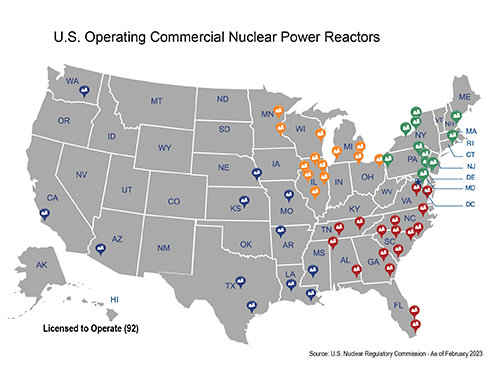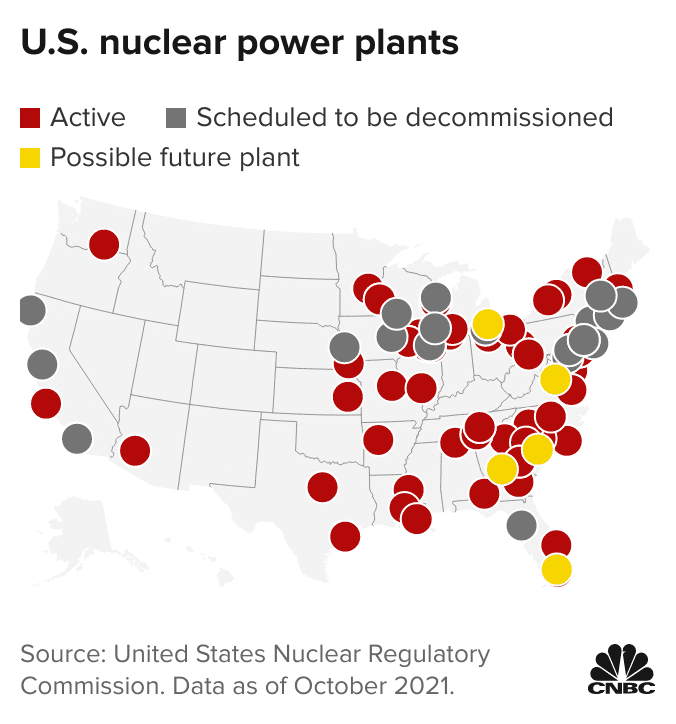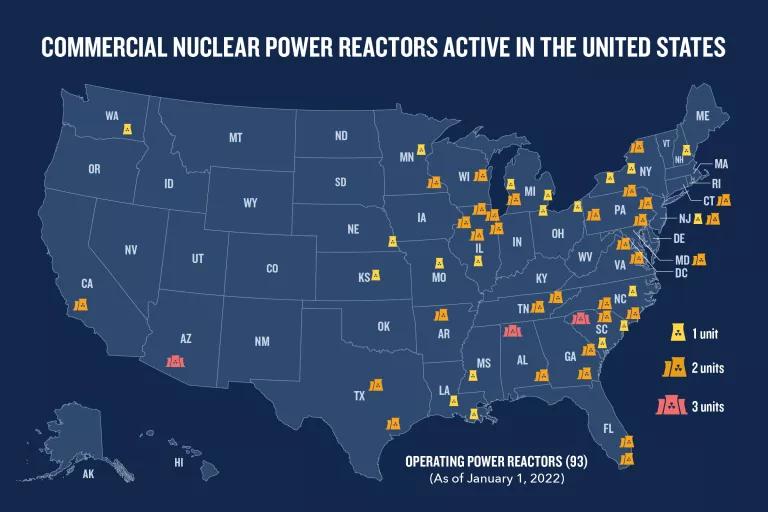Nuclear Power Plants in the United States: Vital Insights
- Update Time : Wednesday, October 23, 2024

As of the latest data, the United States is home to 93 operating nuclear power plants. These facilities are spread across 28 states.
Nuclear power plays a critical role in America’s energy mix, contributing significantly to the nation’s electricity needs with a sizeable portion of carbon-free generation. Embracing both innovation and rigorous safety standards, these plants showcase a steadfast commitment to sustainable energy.
Nuclear energy’s reliability and efficiency make it a cornerstone for meeting both current and future power demands while supporting environmental goals. The industry’s dedication to advancing technology ensures that nuclear power remains a key player in the quest for cleaner energy solutions. Engaging with the topic of nuclear power is essential for understanding the broader landscape of energy production and the paths toward a greener future.
The Role Of Nuclear Energy In The Us
The Role of Nuclear Energy in the US is pivotal. Nuclear plants provide steady, reliable power. They cut greenhouse emissions. They help keep the energy grid stable. Let’s dive into the current landscape and energy contribution of nuclear power in the United States.
Current State Of Nuclear Power
The US runs 92 nuclear reactors. These are in 28 states. They generate about 20% of the country’s electricity. Safety and efficiency are top priorities.
Many plants are over 30 years old. Upgrades and licenses extend their lives. New reactors are under construction. They promise safer, more efficient energy.
Contribution To National Energy Mix
Nuclear energy is a major player. It’s the largest source of clean power. It beats coal and natural gas in low emissions.
Nuclear power supports renewable sources. It provides base-load electricity. This means it’s always on, balancing solar and wind variability.
Let’s look at the energy mix in numbers:
| Energy Source | Percentage |
|---|---|
| Nuclear | 20% |
| Renewables | 17% |
| Natural Gas | 40% |
| Coal | 23% |
In summary, nuclear power is key for a clean, reliable energy future.

Credit: origins.osu.edu
History Of Nuclear Power Development
The history of nuclear power development in the United States is a story of innovation and growth. This journey has shaped the energy landscape, offering a reliable and low-carbon power source. Let’s explore the key milestones and expansion phases of nuclear energy in the U.S.
Early Milestones
The beginning of nuclear power in the U.S. was marked by groundbreaking achievements. The first major milestone was the construction of the Experimental Breeder Reactor I in Idaho. This reactor, in 1951, became the first in the world to generate usable electricity from nuclear energy. This event signaled the potential of nuclear power to change the energy sector.
- 1954: The Atomic Energy Act allowed private companies to build nuclear reactors.
- 1957: The Shipping port Atomic Power Station, the first full-scale commercial nuclear power plant, began operations in Pennsylvania.
Expansion And Growth
The success of early projects led to a period of rapid expansion and growth in the U.S. nuclear industry. The 1970s and 1980s saw a boom in the construction of nuclear power plants. By the mid-1980s, the U.S. had become the world’s largest producer of nuclear energy.
| Decade | New Reactors | Key Developments |
|---|---|---|
| 1970s | 56 | Increased construction of nuclear reactors. |
| 1980s | 34 | Peak of nuclear power plant construction. |
This era of expansion significantly increased the U.S.’s nuclear capacity. It helped establish nuclear power as a key part of the nation’s energy mix. Today, the U.S. continues to lead in nuclear technology and innovation, with ongoing efforts to enhance safety and efficiency.
Key Nuclear Power Plants In Operation
The United States harnesses nuclear energy through several key facilities. These plants play a vital role in America’s energy landscape. Let’s explore some of the most important nuclear power plants currently in operation.
Notable Facilities
- Palo Verde – Arizona’s energy giant
- Plant Vogtle – A Georgia powerhouse
- South Texas Project – Texas’ pride in nuclear energy
Capacity And Performance
These plants not only stand out for their size but also for their performance. They contribute significantly to the nation’s clean energy output.
| Plant Name | Location | Capacity (MW) |
|---|---|---|
| Palo Verde | Arizona | 3,937 |
| Plant Vogtle | Georgia | 2,430 |
| South Texas Project | Texas | 2,700 |
Safety Measures And Protocols
Understanding the safety of nuclear power plants is vital. The United States takes this seriously. Let’s explore the robust safety measures and protocols in place.
Regulatory Framework
The U.S. has strict rules for nuclear safety. The Nuclear Regulatory Commission (NRC) sets these standards. Their goal is to protect people and the environment.
- Licensing: Plants need a license to operate.
- Inspections: Regular checks ensure compliance.
- Enforcement: Rules violations lead to penalties.
All nuclear plants follow NRC regulations. These keep safety top priority.
Technological Advances In Safety
Technology improves nuclear plant safety. Innovations lead to better protection.
| Technology | Benefits |
|---|---|
| Digital Instrumentation | Accurate control of plant operations |
| Passive Safety Systems | Work without human action |
| Advanced Containment Structures | Withstand natural disasters |
These advancements support plant safety. They help prevent accidents.
Economic Impact Of Nuclear Power
The Economic Impact of Nuclear Power is vast and varied. Nuclear power plants provide a stable source of energy. They also play a significant role in the economy. Let’s explore how these plants impact job creation and the overall cost-benefit analysis.
Job Creation And Local Economies
Nuclear power plants are big employers. They offer high-quality, well-paying jobs. These jobs range from engineers to safety inspectors. Not only do these plants employ a lot of people directly, but they also boost local economies. They do so by creating jobs in related sectors. This includes construction, maintenance, and services.
- Direct employment in plant operation
- Indirect jobs in local businesses
This job creation leads to stronger local economies. Communities thrive when nuclear plants operate nearby.
Cost-benefit Analysis
The cost of building and running a nuclear power plant is high. Yet, the benefits are substantial. These plants produce large amounts of electricity. They do so with minimal environmental impact. This is in terms of greenhouse gas emissions.
| Aspect | Benefit |
|---|---|
| Electricity Production | High output with low emissions |
| Economic Boost | Job creation and local economy support |
Nuclear power’s reliability adds value to the grid. This helps keep electricity prices stable. The long-term benefits often outweigh the initial costs. This makes nuclear power a financially sound choice for energy production.
Public Perception And Opinion
The debate around nuclear power plants in the United States is complex. People hold strong opinions on this topic. Understanding these views is crucial for energy policy.
Shifts In Acceptance
Public opinion on nuclear energy has changed over time. Safety concerns and environmental awareness influence these shifts. Recent trends show a growing acceptance of nuclear power. This shift is due to its low-carbon footprint.
- Climate change awareness boosts nuclear energy support.
- Technological advancements promise safer reactors.
- Energy demand increases push for reliable power sources.
Influencing Factors
Several key factors shape public perception of nuclear energy. Education and media play significant roles in forming opinions.
| Factor | Impact on Perception |
|---|---|
| Media coverage | Shapes public awareness and fear |
| Educational outreach | Improves understanding and acceptance |
| Historical incidents | Raises safety concerns |
| Government policies | Influences trust and support |
Open dialogues and transparent information are key. They help build trust in nuclear energy as a power source.
Environmental Considerations
Environmental considerations play a key role in the debate over nuclear power plants in the United States. These plants offer a mix of benefits and challenges that impact our planet. Understanding these factors is crucial for a balanced view on nuclear energy.
Emissions And Climate Change
Nuclear power plants generate vast amounts of energy. They do this with low greenhouse gas emissions. This fact positions nuclear as a friend to our climate.
Nuclear energy helps to reduce carbon footprints. It compares favorably with coal and natural gas. Nuclear power plants do not produce carbon dioxide while generating electricity.
By avoiding fossil fuels, nuclear helps combat climate change. This makes it a critical part of our energy mix.
Waste Management Challenges
Nuclear power is clean while producing energy. Yet, it creates radioactive waste that needs careful handling.
- High-level waste: This is spent nuclear fuel. It is dangerous and needs secure storage for thousands of years.
- Low-level waste: Items like tools and work clothing get contaminated. They require disposal in protected facilities.
Waste management is a complex task. It includes transportation, storage, and monitoring. The goal is to protect people and the environment.
Safe waste disposal methods are a priority. They ensure that the benefits of nuclear energy do not come at an environmental cost.

Credit: www.cnbc.com
The Future Of Nuclear Energy In The Us
The future of nuclear energy in the United States stands at a crossroads. This clean, reliable power source plays a pivotal role in meeting energy demands while reducing carbon emissions. As the country grapples with climate change, the evolution of nuclear technology and supportive policies will shape the energy landscape.
Innovations In Nuclear Technology
Nuclear technology is advancing rapidly. New reactor designs promise enhanced safety and efficiency. Small Modular Reactors (SMRs) are a game changer. They offer flexible deployment and lower initial costs. These innovations could revolutionize how the US generates nuclear power.
- SMRs can fit in smaller sites
- They reduce upfront investment
- Advanced reactors boost safety
Researchers are also exploring fusion energy. It could provide almost limitless power. With zero greenhouse gas emissions, fusion represents the ultimate clean energy source.
Policy And Investment Trends
Government policy and investment are crucial for nuclear energy’s future. The US government supports nuclear research and development. This helps drive innovation. Tax incentives and funding for nuclear projects encourage private investment.
| Policy | Impact |
|---|---|
| Research & Development Support | Drives innovation in technology |
| Tax Incentives | Attracts private investment |
| Funding for Projects | Helps new reactors to be built |
Public-private partnerships are also key. They blend resources and expertise. This speeds up the development of new nuclear technologies. The government’s role in facilitating these partnerships is vital.
With the right mix of innovation, policy, and investment, the US could lead a new nuclear era. This would ensure energy security and environmental protection for future generations.

Credit: www.nrdc.org
Frequently Asked Questions
How Many Nuclear Plants Are In The Us?
There are currently 93 commercial nuclear reactors at 56 nuclear power plants in the United States. These reactors contribute to approximately 20% of the nation’s electricity.
What Is The Largest Nuclear Power Plant In The Us?
The Palo Verde Nuclear Generating Station in Arizona is the largest nuclear power plant in the US. It has three reactors, with a total net summer generating capacity of about 3,937 MW.
Are New Nuclear Plants Being Built In The Us?
As of my knowledge cutoff in early 2023, two new nuclear reactors are under construction at the Vogtle Electric Generating Plant in Georgia. They are expected to start operating within the next few years.
When Was The First Us Nuclear Power Plant Commissioned?
The first commercial nuclear power plant in the US, the Shippingport Atomic Power Station in Pennsylvania, was commissioned in 1957. It signaled the birth of nuclear energy in the country.
Conclusion
Nuclear power plants play a pivotal role in the United States’ energy landscape. They offer a reliable and low-carbon power source, crucial for meeting energy demands while combating climate change. As we embrace cleaner energy solutions, the significance of these facilities cannot be overstated.
Their continued operation and potential expansion are key to a sustainable future.


















Leave a Reply